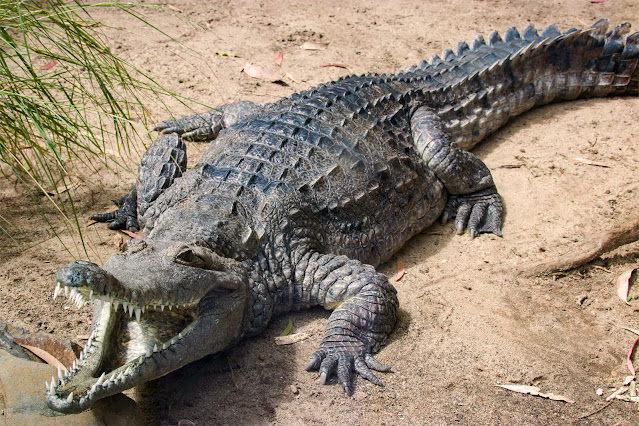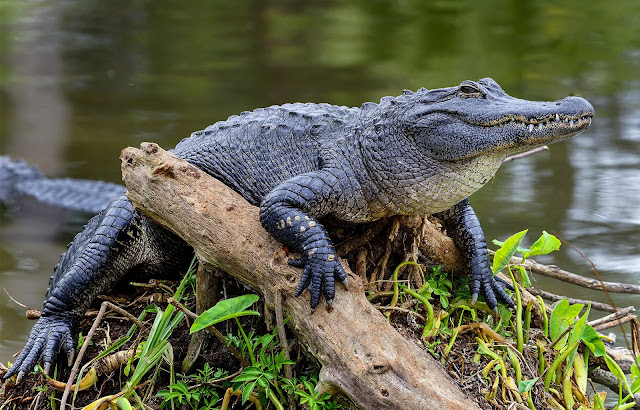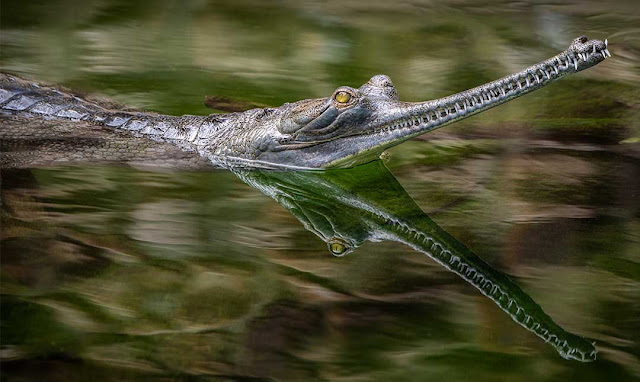Discover the key differences between crocodiles, alligators, gharials, caimans, and false gharials in this quick guide to the ancient reptilian family of crocodilians.
Know Your Crocodilians: A Quick Guide to These Ancient Reptiles
Crocodilians have roamed the Earth for over 200 million years, surviving mass extinctions and evolving into some of the planet’s most fascinating apex predators. While most people lump them all under the label of "crocodiles," the crocodilian family actually includes several distinct members: crocodiles, alligators, gharials, false gharials, and caimans. Each of these species has unique features and behaviors adapted to their environments.
Let’s take a closer look at these ancient reptiles and learn how to tell them apart.
 |
| Crocodile |
1. Crocodile – The Global Predator
Crocodiles are perhaps the most well-known and widely distributed of the crocodilian family. They have narrow, V-shaped snouts, and when their mouths are shut, the fourth tooth on the lower jaw remains visible, a key identifier.
These powerful reptiles are found across Africa, Asia, the Americas, and Australia, often in freshwater and coastal habitats. They are aggressive hunters with strong territorial behavior, capable of taking down large prey.
 |
| Alligator |
2. Alligator – The Swamp King
Alligators are primarily found in the United States and China. Their most noticeable feature is their broad, U-shaped snout, which is wider and more rounded than that of a crocodile.
Another distinguishing trait is their dental structure: when their mouth is closed, only the upper teeth are visible. Alligators prefer freshwater environments like swamps, marshes, and slow-moving rivers, and are generally less aggressive than crocodiles.
 |
| Indian Gharial |
3. Indian Gharial – The Fish Specialist
Among all crocodilians, the Indian Gharial stands out with its extremely long, narrow snout, designed specifically for catching fish. This snout is filled with dozens of sharp, interlocking teeth, making it a formidable predator in the water.
Native to the rivers of the Indian subcontinent, the gharial is critically endangered, facing threats from habitat destruction and water pollution. Despite its intimidating appearance, it poses little danger to humans due to its fish-only diet.
 |
| False Gharial |
4. False Gharial – The Mysterious Mix
Often mistaken for the true gharial, the False Gharial also has a long snout, though not as narrow or elongated. It features a blend of physical traits from both crocodiles and gharials, giving it a unique identity in the crocodilian world.
Found in the swamps and rivers of Malaysia and Indonesia, the false gharial is less studied but equally fascinating. It feeds on fish and small mammals, and its conservation status is currently vulnerable.
 |
| Caiman |
5. Caiman – The Jungle Lurker
Caimans are smaller relatives of the alligator and are native to Central and South America. They can be identified by their rougher scales and larger, bulging eyes, which help them hunt in murky waters.
Despite their smaller size, caimans are fierce predators that thrive in diverse aquatic habitats – from rainforest rivers to flooded plains. Some species, like the black caiman, can grow impressively large and are apex predators in their ecosystems.
Final Thoughts
From the aggressive saltwater crocodile to the fish-loving gharial, each crocodilian tells a different evolutionary story. Their adaptations, from jaw shape to habitat preference, are a testament to millions of years of survival and specialization.
Next time you spot a croc-like creature, look closely at the snout shape, tooth visibility, and region — you might be staring at something much rarer than you think.
